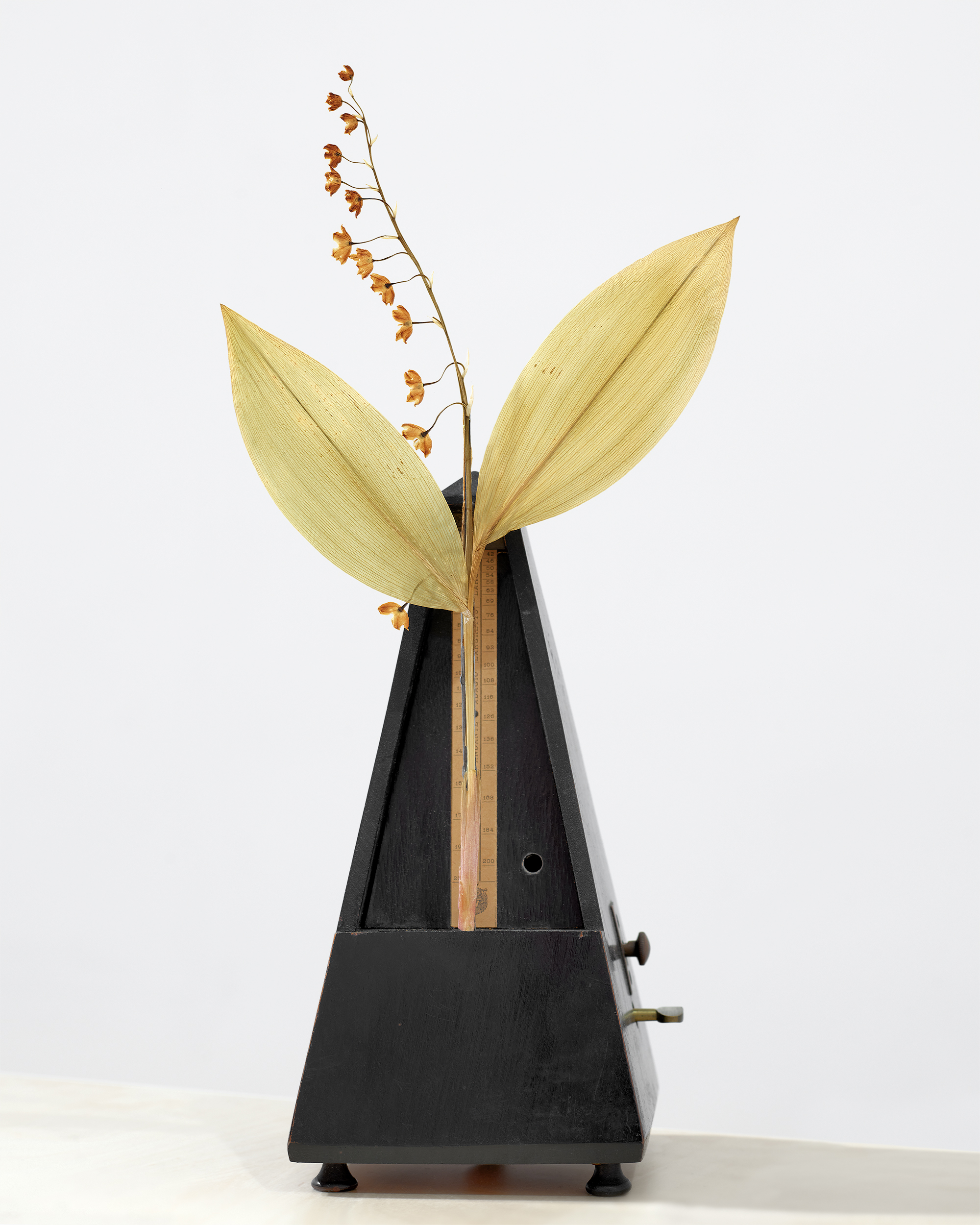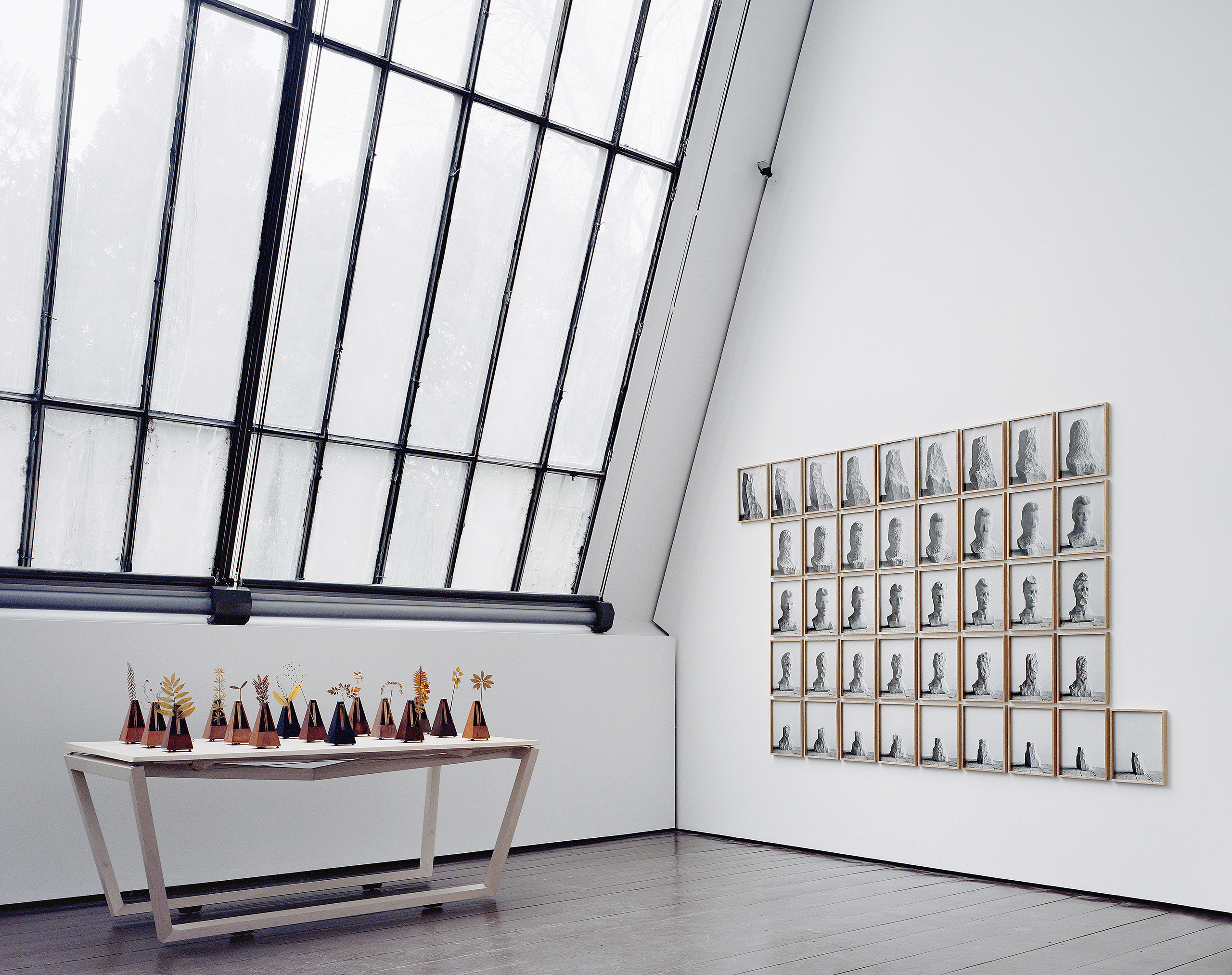Garden of Persistence
2020-2023
![]()
2020-2023

Garden of Persistence, 2020–2023, kinetic table, wood, steel wire, magnets, antique metronomes, 19th-centuryherbarium specimens, 110 × 200 × 120 cm, the kinetic table was designed by Árpád Hunor György and built by Heonlab, installation view: Hypothesis: Everything is Leaf, Foto Wien, Atelier Augarten, Vienna, Austria, 2022, image by Zalán Péter Salát and Csaba Villányi
Vegetal and human temporalities are not identical. The essence of human ontology does not originate from our life itself, but its finitude. Plants are not aware of their own finitude; therefore they entirely subordinate their existence to life itself. The rhythm of human time consciousness is confused and heterogeneous. In addition, human beings are actually never identical with themselves, our temporality is nothing other than continuous planning, a constant projection of our future self. In contrast, the lack of self-awareness obliges a plant to adjust exclusively to the temporality of its medium, i.e. that it should unceasingly obey the laws of its environment. The succession of night and day, the changing seasons, the constant repetition that accompany growth, the continual self-hiatus and resumption, and the rhythm of cyclic character all represent vegetal chronology, the image of Nietzsche’s eternal return (Ewige Wiederkunft). So a vegetal body exists according to a different time compared with a human body, yet its existence is still fragile and finite. Thus, we can also feel its significance. In The Metamorphosis of Plants Goethe emphasizes the rhythm of growth and metamorphosis. The continual reaction to the rhythm of the environment and the flow of nutrients resemble a tune. The mechanical synchronisation of processes is like music.
Garden of Persistence, 2020-2023, kinetic table, wood, steel wire, magnets, antique metronomes, 19th century herbarium specimens, 110 x 200 x 120 cm
The Garden of Persistence is a kinetic installation. Fifteen antique metronomes are standing on the surface of a table which is floating and moving on steel wires. Plants from 19th-century herbaria are closely attached to each pendulum of the metronomes. The metronome-plants, i.e., the mechanical-organic units, begin to communicate with each other “chaotically” once wound. Thus a connection is established among them due to the transmission of their kinetic energy, and they slowly become synchronized with one another. Yet they nearly immediately lose the synchronous movement, although they find it again, and so on as the pattern repeats itself. There are several examples of synchronization in vegetal communication and in the mode of vegetal existence in general. It is also the cause of the periodic flashing of light produced by fireflies, the simultaneous chirping of crickets, the synchronized distress signals of frogs and the interlinking lightning activity in distant storm centers. The principle of synchronization also explains why the parts, and even the cells, of a healthy human or non-human heart beat synchronously.
It is now well established that plant photoreceptors govern specific activities. There is a photoreceptor which instructs a plant to turn towards the light, another tells it when to germinate, while yet another informs it about too much light, and so on. Photoreceptors also have the task of timing, that is, the operation of the circadian clock. The vegetal circadian clock is a “molecular metronome” which, similarly to the timing machinery of human beings and animals, regulates and synchronizes physiological processes. For example, it helps a plant to detect when it is daytime or night. In accordance with the parts of the day, it is also the circadian clock that sets appropriate metabolism, growth, and flowering of a plant. How well this internal chronometer synchronizes with day length and the seasons strongly influences plant health. An increasing number of indicators show that global warming disturbs the circadian clock of plants. As a result, the timing of the recurring events of vegetal life cycles becomes confused and the loss of synchronization critically affects the ecosystem. A main reason is that disorder within individual plants impairs communication among them. In vegetal communication synchronization plays a significant role in harmonizing physiological activities, the distribution of resources, adaptation to the environment and the communication with animals. The correct operation of the molecular metronome of plants is the basis for the appropriate functioning of the ecosystem.


Garden of Persistence, 2020-2023, kinetic table, wood, steel wire, magnets, antique metronomes, 19th century herbarium specimens, detail

Garden of Persistence, 2020-2023, kinetic table, wood, steel wire, magnets, antique metronomes, 19th century herbarium specimens, detail

Garden of Persistence, 2020-2023, kinetic table, wood, steel wire, magnets, antique metronomes, 19th century herbarium specimens, detail

Garden of Persistence, 2020-2023, kinetic table, wood, steel wire, magnets, antique metronomes, 19th century herbarium specimens, detail

Garden of Persistence, 2020-2023, kinetic table, wood, steel wire, magnets, antique metronomes, 19th century herbarium specimens, 110 x 200 x 120 cm, installation view: Hypothesis: Everything is Leaf, Foto Wien, Atelier Augarten, Vienna, Austria, 2022, image by Rudolf Strobl

Garden of Persistence and Variations on the Self, installation view: Hypothesis: Everything is Leaf, Foto Wien, Atelier Augarten, Vienna, Austria, 2022, image by Zalán Péter Salát and Csaba Villányi
